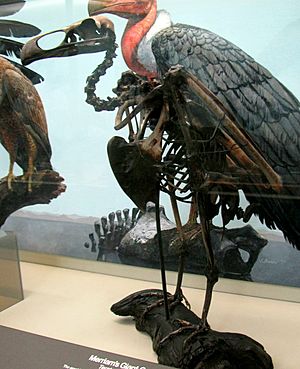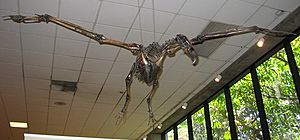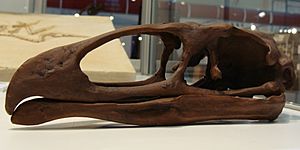Teratornis facts for kids
Quick facts for kids TeratornisTemporal range: Early Pleistocene – Late Pleistocene
|
|
|---|---|
 |
|
| T. merriami skeleton from the La Brea tar pits | |
| Scientific classification |
|
| Kingdom: | Animalia |
| Phylum: | Chordata |
| Class: | Aves |
| Order: | Cathartiformes |
| Family: | †Teratornithidae |
| Genus: | †Teratornis L. H. Miller, 1909 |
| Type species | |
| Teratornis merriami Miller, 1909
|
|
| Species | |
|
|
| Synonyms | |
|
|
Teratornis was a type of huge bird of prey that lived in North America. These birds were part of a group called teratorns. We know about two main species: Teratornis merriami and Teratornis woodburnensis.
Scientists have found many fossil bones from over 100 different Teratornis birds. Most of these bones were found in the La Brea Tar Pits in California. Other bones have been found in Oregon, Nevada, Arizona, and Florida. Most of these fossils are from the Late Pleistocene period, which ended about 10,000 years ago.
Contents
Meet the Giant Teratorns
The name Teratornis means "monster bird," and for good reason! These birds were truly enormous.
- Teratornis merriami: This is the most well-known species. Over a hundred of its skeletons have been found, mostly from the La Brea Tar Pits. This bird stood about 75 cm (29.5 in) tall. Its wings could spread out to about 3.5 to 3.8 meters (11.5 to 12.5 ft) wide. It weighed around 15 kg (33 lb), making it much bigger than today's condors. T. merriami died out about 10,000 years ago, at the end of the last Ice Age.
- Teratornis woodburnensis: This species was found in Oregon in 1999. Scientists found parts of its wing bone, skull, beak, and other bones. These pieces suggest it had a wingspan of over 4 meters (14 ft)! This bird lived about 12,000 years ago. Its bones were found near fossils of other huge Ice Age animals. These included mammoths, mastodons, and ground sloths. There was also evidence that early humans lived in the area at that time.
Another bird, "Teratornis" olsoni, was found in Cuba. Scientists are still figuring out if it was a true teratorn. Besides this bird and some fossils from Ecuador, teratorns mostly lived in North America.
What Did Teratornis Look Like?
Teratornis merriami was a very impressive bird. Its wingspan was about 3.5 to 3.8 m (11 to 12 ft). It stood about 75 cm (30 in) tall. It weighed around 15 kg (33 lb). This made it heavier than today's Californian condor. There was an even bigger relative called Aiolornis. It was about 40% larger and lived even earlier.
The bones in its "fingers" were fused together, just like in modern birds. However, part of its index finger was shaped to help support its long, strong flight feathers. These feathers helped the bird use strong air currents to fly.
Its legs were like those of an Andean condor, but stronger. Its feet could hold onto prey to tear off pieces. But they couldn't grip as tightly as the feet of a hawk or eagle. Teratornis merriami could take off by just jumping and flapping its wings. It was better at this than condors, which often need a short run to take off.
How Teratornis Lived and Hunted
T. merriami probably lived a bit like modern condors. But its larger beak suggests it was also a more active hunter. It might have swallowed small prey, like rabbits, whole. For larger dead animals (called carrion), it would have eaten them like condors or vultures do.
Many Teratornis fossils were found in the La Brea Tar Pits. These pits were sticky pools of asphalt (tar) where water collected. Large Ice Age animals would get stuck in the tar while trying to drink. Then, Teratornis birds would come to eat the dead animals and get stuck themselves.
Merriam's Teratorn likely helped other smaller birds, like eagles and ravens, get to the meat of large carcasses. Mammal predators couldn't fly, so they often got stuck in the tar if they tried to reach the dead animals.
Scientists also think T. merriami might have hunted fish. Its skull and beak shape suggest this. Its strong legs and claws, which weren't quite as good for gripping as an eagle's, point to a hunting style like an osprey. Ospreys dive into water to catch fish. This idea helps explain why so many of these powerful flying birds got stuck in the tar pits. They might have been hunting fish in the water that covered the sticky asphalt.
Why Teratornis Disappeared
Teratornis likely became extinct because of big changes at the end of the last Ice Age. The climate changed, which affected the environment and made food harder to find. Human hunting and changes to habitats also played a role. Many large land animals disappeared, and this meant less food for Teratornis.
Even though Teratornis was a better hunter than the California Condor, it wasn't as good at hunting small prey as hawks and eagles. Condors had more flexible diets and larger populations, which helped them survive. Recent studies suggest that California condors survived by also eating dead marine mammals found along the Pacific Coast. Teratornis relied more on land mammals for food. So, when those mammals died out, Teratornis couldn't survive.
Images for kids
See also
 In Spanish: Teratornis para niños
In Spanish: Teratornis para niños








